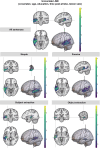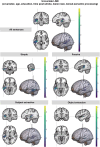Mapping sentence comprehension and syntactic complexity: evidence from 131 stroke survivors
- PMID: 39554380
- PMCID: PMC11565230
- DOI: 10.1093/braincomms/fcae379
Mapping sentence comprehension and syntactic complexity: evidence from 131 stroke survivors
Abstract
Understanding and interpreting how words are organized in a sentence to convey distinct meanings is a cornerstone of human communication. The neural underpinnings of this ability, known as syntactic comprehension, are far from agreed upon in current neurocognitive models of language comprehension. Traditionally, left frontal regions (e.g. left posterior inferior frontal gyrus) were considered critical, while more recently, left temporal regions (most prominently, left posterior middle temporal gyrus) have been identified as more indispensable to syntactic comprehension. Syntactic processing has been investigated by using different types of non-canonical sentences i.e. those that do not follow prototypical word order and are considered more syntactically complex. However, non-canonical sentences can be complex for different linguistic reasons, and thus, their comprehension might rely on different neural underpinnings. In this cross-sectional study, we explored the neural correlates of syntactic comprehension by investigating the roles of left hemisphere brain regions and white matter pathways in processing sentences with different levels of syntactic complexity. Participants were assessed at a single point in time using structural MRI and behavioural tests. Employing lesion-symptom mapping and indirect structural disconnection mapping in a cohort of 131 left hemisphere stroke survivors, our analysis revealed the following left temporal regions and underlying white matter pathways as crucial for general sentence comprehension: the left mid-posterior superior temporal gyrus, middle temporal gyrus and superior temporal sulcus and the inferior longitudinal fasciculus, the inferior fronto-occipital fasciculus, the middle longitudinal fasciculus, the uncinate fasciculus and the tracts crossing the most posterior part of the corpus callosum. We further found significant involvement of different white matter tracts connecting the left temporal and frontal lobes for different sentence types. Spared connections between the left temporal and frontal regions were critical for the comprehension of non-canonical sentences requiring long-distance retrieval (spared superior longitudinal fasciculus for both subject and object extraction and spared arcuate fasciculus for object extraction) but not for comprehension of non-canonical passive sentences and canonical declarative sentences. Our results challenge traditional language models that emphasize the primary role of the left frontal regions, such as Broca's area, in basic sentence structure comprehension. Our findings suggest a gradient of syntactic complexity, rather than a clear-cut dichotomy between canonical and non-canonical sentence structures. Our findings contribute to a more nuanced understanding of the neural architecture of language comprehension and highlight potential directions for future research.
Keywords: aphasia; comprehension; disconnection; lesion; syntax.
© The Author(s) 2024. Published by Oxford University Press on behalf of the Guarantors of Brain.
Conflict of interest statement
The authors report no competing interests.
Figures






References
-
- Bates E, Wilson SM, Saygin AP, et al. Voxel-based lesion-symptom mapping. Nat Neurosci. 2003;6(5):448–450. - PubMed
-
- Sperber C, Griffis J, Kasties V. Indirect structural disconnection-symptom mapping. Brain Struct Funct. 2022;227(9):3129–3144. - PubMed
-
- Friederici AD. The brain basis of language processing: From structure to function. Physiol Rev. 2011;91(4):1357–1392. - PubMed
-
- Bornkessel-Schlesewsky I, Schlesewsky M. Reconciling time, space and function: A new dorsal-ventral stream model of sentence comprehension. Brain Lang. 2013;125(1):60–76. - PubMed
Grants and funding
LinkOut - more resources
Full Text Sources
